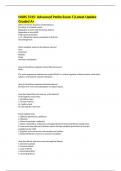Tentamen (uitwerkingen)
NURS 5315: Advanced Patho Exam 5|Latest Update Graded A+
- Vak
- Instelling
NURS 5315: Advanced Patho Exam 5|Latest Update Graded A+ What are the key functions of the kidneys? Excretion of metabolic waste. Regulation of water and electrolyte balance Regulation of arterial BP Erythrocyte production 1, 25 -dihyydroxy vitamin production (calcitriol) Gluconeogenesis ...
[Meer zien]




